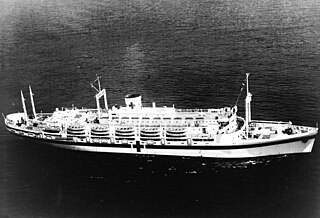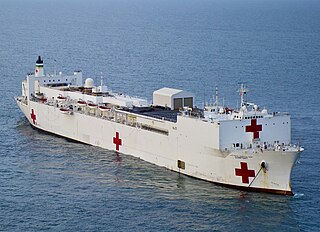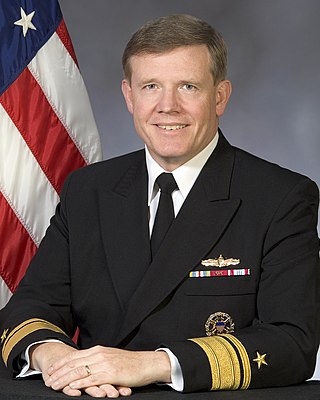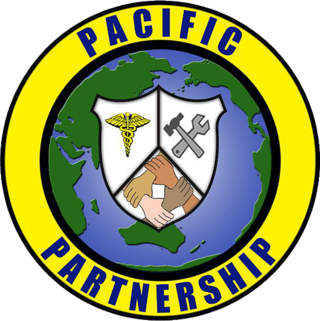Three hospital ships of the United States Navy have borne the name USS Mercy, in honor of the virtue of compassion.

USNS Mercy (T-AH-19) is the lead ship of her class of hospital ships in non-commissioned service with the United States Navy. Her sister ship is USNS Comfort (T-AH-20). She is the third US Navy ship to be named for the virtue mercy. In accordance with the Geneva Conventions, Mercy and her crew do not carry any offensive weapons, though defensive weapons are available.

The second USS Mercy (AH-8) was a Comfort-class hospital ship laid down under Maritime Commission contract by Consolidated Steel Corporation at the Wilmington Yard, Wilmington, California, on 4 February 1943. She was acquired by the US Navy from the Maritime Commission on 25 March 1943 and launched the same day, sponsored by Lieutenant Doris M. Yetter, NC, USN, who had been a prisoner of war on Guam in 1941. She was converted from a cargo ship to a hospital ship by Los Angeles Shipbuilding & Drydock Company, San Pedro, California and commissioned 7 August 1944.

USNS Comfort (T-AH-20) is a Mercy-class hospital ship of the United States Navy.

USS Hope (AH-7) was a Comfort-class hospital ship launched under Maritime Commission contract by Consolidated Steel Corporation, Wilmington, California, 30 August 1943; sponsored by Miss Martha L. Floyd; acquired by the Navy the same day for conversion to a hospital ship by U.S. Naval Dry Dock, Terminal Island, Calif.; and commissioned 15 August 1944.
A joint support ship (JSS) is a multi-role naval vessel capable of launching and supporting joint amphibious and airlift operations. It can also provide command and control, sealift and seabasing, underway replenishment, disaster relief and logistics capabilities for combined land and sea operations.

Rear Admiral Robert Dunham Reilly Jr. was a United States Navy Surface Warfare Flag Officer who retired from active duty in January 2010 after 34-plus years of military service. His last assignment was as the 24th commander of the U.S. Navy's Military Sealift Command (MSC).

USNS Richard E. Byrd (T-AKE-4) is a Lewis and Clark-class dry cargo ship of the United States Navy. She is the second United States Navy ship to be named after polar explorer Rear Admiral Richard E. Byrd (1888–1957). Built by the National Steel and Shipbuilding Company at San Diego, California, the ship was launched on 15 May 2007. Richard E. Byrd was delivered to Military Sealift Command on 8 January 2008.

USNS Tippecanoe (T-AO-199) is a Henry J. Kaiser-class underway replenishment oiler operated by the Military Sealift Command (MSC) to support ships of the United States Navy. She serves in the United States Pacific Fleet. Tippecanoe, the thirteenth ship of the Henry J. Kaiser class, was laid down at Avondale Shipyard, Inc., at New Orleans, Louisiana, on 19 November 1990 and launched on 16 May 1992. She entered non-commissioned U.S. Navy service under the control of the MSC with a primarily civilian crew on 8 February 1993.

USNS Big Horn (T-AO-198) is a Henry J. Kaiser-class replenishment oiler of the United States Navy.

USNS Sioux (T-ATF-171) was a United States Navy Powhatan-class tugboat operated by the Military Sealift Command (MSC). She was in service from 1981 to 2021 and spent the bulk of this time supporting the Pacific Fleet.

Daishan Dao is a Type 920 hospital ship of the People's Liberation Army Navy of the People's Republic of China. Daishan Dao is also known as Peace Ark during peacetime, and has received NATO reporting name Anwei class.

Pacific Partnership is an annual deployment of forces from the Pacific Fleet of the United States Navy (USN), in cooperation with regional governments and military forces, along with humanitarian and non-government organizations.
The Naval Fleet Auxiliary Force is a division of the US Navy. The 42 ships of the Military Sealift Command's Naval Fleet Auxiliary Force are the supply lines to U.S. Navy ships at sea. These ships provide virtually everything that Navy ships need, including fuel, food, ordnance, spare parts, mail and other supplies. NFAF ships enable the Navy fleet to remain at sea, on station and combat ready for extended periods of time. NFAF ships also conduct towing, rescue and salvage operations or serve as floating medical facilities. All NFAF ships are government owned and crewed by civil service mariners. Some of the ships also have a small contingent of Navy personnel aboard for operations support, supply coordination and helicopter operations.
The Coalition of Hope Foundation, Inc. (COH) is a US-based 501(c)(3), not-for-profit, charitable organization that provides global humanitarian assistance and disaster-relief support. COH was founded by Timothy J. Keegan in 2010.

USNS Pecos (T-AO-197) is a Henry J. Kaiser-class underway replenishment oiler operated by the Military Sealift Command to support ships of the United States Navy, and the third such ship to be named after the Pecos River.

The San Clemente-class oil tanker is a class of oil tankers built by National Steel and Shipbuilding Company (NASSCO), San Diego. The size places them in the category of super tankers. They were built to serve the Trans-Alaska Pipeline System. At the time of completion National Steel and Shipbuilding Company was equally owned by Kaiser Industries Corporation and Morrison-Knudsen Company, Inc.

In connection with the COVID-19 pandemic, navies from several countries deployed hospital ships to combat the disease. Aside from providing health services, hospital ships would allow civilian hospitals to offload some of the patients, relieving the pressure on facilities ashore. However, this also means that each ship would battle the onboard outbreaks of their own

The COVID-19 pandemic spread to many military ships. The nature of these ships, which includes working with others in small enclosed areas and a lack of private quarters for the vast majority of crew, contributed to the rapid spread of the disease, even more so than on cruise ships.













